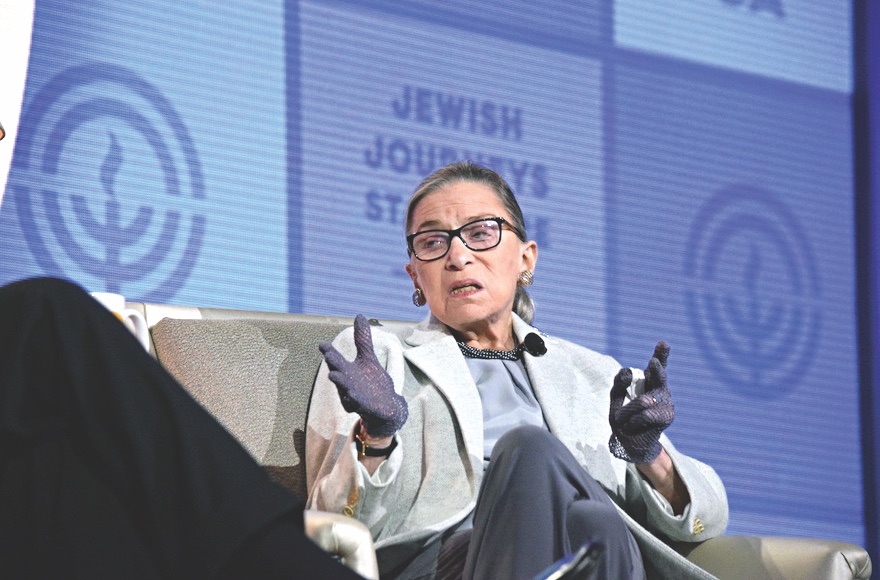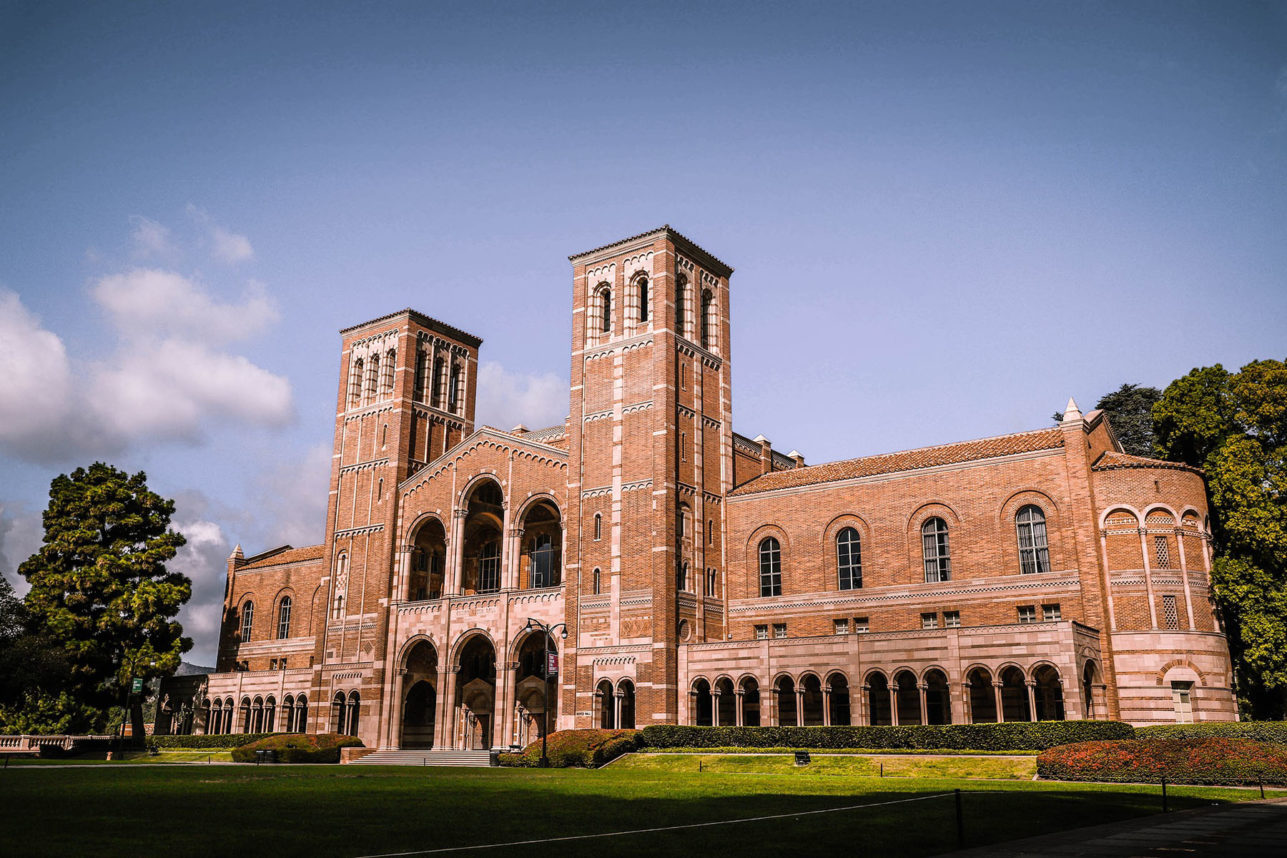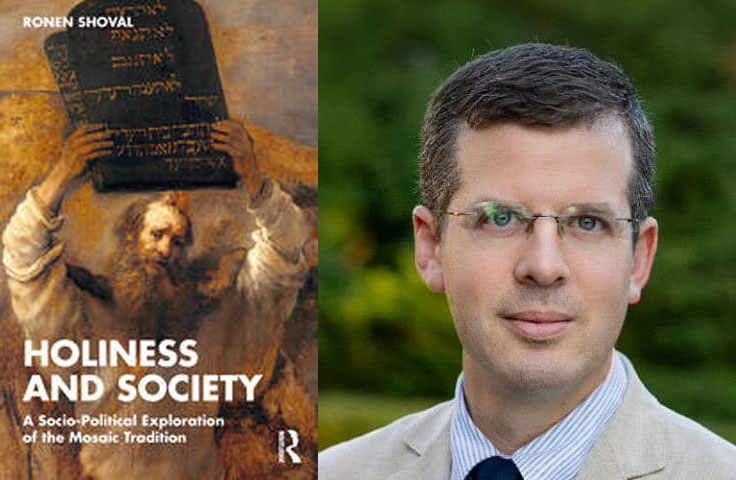 Ruth Bader Ginsburg speaking to the General Assembly of the Jewish Federations of North America in Washington, D.C., Nov. 11, 2016. Photo by Bob Jacob/Cleveland Jewish News
Ruth Bader Ginsburg speaking to the General Assembly of the Jewish Federations of North America in Washington, D.C., Nov. 11, 2016. Photo by Bob Jacob/Cleveland Jewish News In the Babylonian Talmud, there is a tale about King Yannai and Shimon ben Shetah, a prominent sage and head of the Sanhedrin (the high court), who both lived — at least in the rabbinic imaginary — around the first century before the Common Era (Sanhedrin 19a). In the story, one of King Yannai’s servants killed a person, so Shimon summoned him for judgment. But Shimon also summoned Yannai as the ultimately responsible party and ordered him to stand and give testimony.
The king was insulted that he was forced to stand in front of 71 seated justices. So Yannai refused, saying that he would testify only if all of Shimon’s colleagues on the court ordered him to do so. Yannai had hoped that not every judge had Shimon’s spine — and he was right. When Yannai looked at each judge, they all buried their heads. Realizing that the rest of the court had not backed his decision, Shimon cursed them, and the angel Gabriel smote them. For this reason, the Talmud mandates that a king neither judges nor is he judged.
This story is obviously not the reason for this law. The law instead grew out of the tension between a justice system and a monarch. In the story, though, the Mishnah’s authors captured the limits of jurisprudence, the fragility of judicial institutions and the danger of relying on the courage of one justice. The fact the sages inscribed this story as the law’s origin story demonstrates the weakness of law in the face of raw power. The sages all were killed. Shimon ben Shetah miscalculated, and he lost. The law lost.
On the first night of Rosh Hashanah this year, Shimon ben Shetah died.
As Jill Lepore recently wrote, “Ginsburg bore witness to, argued for, and helped to constitutionalize the most hard-fought and least-appreciated revolution in modern American history: the emancipation of women.”
Ruth Bader Ginsburg was born on March 15, 1933, in Brooklyn, N.Y., to immigrant parents. As the second female on the Supreme Court, she became a legend and an icon of the feminist movement. However, this was not the obvious trajectory of her life.
Ginsburg grew up in an immigrant Jewish neighborhood in Flatbush, and she always retained loyalty to her heritage. As she said in a speech to the American Jewish Committee in 1996: “I am a judge, born, raised and proud of being a Jew. … The demand for justice, for peace and for enlightenment runs through the entirety of Jewish history and Jewish tradition.”
Her mother, Celia Bader, supported her daughter’s intellectual ambitions, and she set aside money so her daughter could attend college. Ginsburg married young and followed her husband, Martin Ginsburg, to his military post and then to Harvard Law School. Martin Ginsburg became an officer to fulfill his ROTC requirements, and she, being pregnant, was allowed only to be a secretary because any other job would require that she travel for training. An often-told anecdote recounts that at the end of her first year at Harvard, Ruth Bader Ginsburg and the eight other women in her class were summoned to the dean’s residence for dinner. At that dinner, the dean asked the women to justify why they were taking a man’s place at the school. Ginsburg replied that she was studying the law to understand her husband’s profession better. To many, Ruth Bader Ginsberg seemed destined to fulfill the role that many white Jewish women filled in mid-century America — housewife with a profession secondary to her husband’s.
Yet, as Jill Lepore recently wrote, “Ginsburg bore witness to, argued for, and helped to constitutionalize the most hard-fought and least-appreciated revolution in modern American history: the emancipation of women. Aside from Thurgood Marshall, no single American has so wholly advanced the cause of equality under the law.”
How did she get from there to here? Despite her qualifications, Ginsburg couldn’t obtain employment as a lawyer because of her religion and gender. Instead, she began work at Columbia University on a comparative project, which required that she learn Swedish and spend time in Sweden. Ultimately, Ginsburg wrote a treatise on Swedish civil law, which remains a leading work. More importantly, she witnessed a society that was more equitable than the United States. Feminism was flourishing in Sweden, child care was readily available, and it was not unusual for women to combine their parenting and professional roles. As they say, “You can’t be what you can’t see.”
After this period, Ginsburg embarked on her feminist legal career, teaching law at Rutgers and then at Columbia. Outside of the classroom, Ginsburg handled discrimination cases for the American Civil Liberties Union. One of the more notable cases she worked on — although she didn’t argue the case in front of the court — was Reed v. Reed. It challenged an Idaho statute that gave preference to men in executing estates. In writing the majority decision, Chief Justice Warren E. Burger used Ginsburg’s now famous phrase, proclaiming, “The choice in this context may not lawfully be mandated solely on the basis of sex.” Ginsburg also co-authored a first-of-its-kind textbook on sex discrimination and law. By the time she was nominated and confirmed as a Supreme Court justice in 1993, she was able to rule from precedents in cases that she had argued in front of the court.
However, the political winds shifted, and Ginsburg attained her “Notorious RBG” moniker from her scathing dissents. She called out the Conservative wing of the court for gutting the Voting Rights Act (Shelby County v. Holder); for not recognizing the realities of employment in the Lilly Ledbetter pay-discrimination case, which led to new congressional legislation; and on and on. She was fearless in calling out power in her dissents. In the Shelby case, Ginsburg likened the majority opinion to a person holding an umbrella in a storm and deciding he does not need it any more since he is dry. Her dissents extended beyond the bench. In 2016, for example, Ginsburg got into trouble for calling President Donald Trump a “faker” and had to apologize. Her last public statement, dictated to her granddaughter Clara Spera, was, “My most fervent wish is that I will not be replaced until a new president is installed.”
Like Shimon ben Shetah, however, Ginsburg also miscalculated and erred. Many who urged her to retire in 2012, when President Barack Obama could have nominated a new justice who would have been approved by the Democratic majority in the Senate. However, this calculation comes with great hindsight. Although RBG seemed to have mastered popular culture, she missed the shift in culture that was represented by the Black Lives Matter movement. She spoke disparagingly of Colin Kaepernick’s protest, and she was part of the majority (with Sonia Sotomayor the lone dissent) in Kansas v. Glover, a case that legitimated traffic stops for no discernible reason.
We are at another moment when it seems that “you can’t be what you can’t see.” Activists in the streets, especially Black activists, are showing us that there is a new vision — a vision of a different kind of safety that is not dependent on armed police and an out-of-control carceral system. That vision is not yet in the court, and if the Senate is able to confirm Trump’s choice for a new justice, that vision may be denied. Without the vision and the courage of Shimon ben Shetah to back it up, the court will be a subsidiary of the executive branch — a rubber stamp to the president’s will.
Ginsburg’s legacy is that brilliance, tenacity and vision matter. And as Ginsburg showed in her Ledbetter dissent, it is crucial for justices to understand the lived reality of impacted peoples (Ginsburg, for instance, had suffered pay discrimination). This humanity is also part of her legacy. The law cannot be so distant from the people that it loses touch.
As we enter this new year, it seems that we may have a Yannai that threatens the justices and has no regard for justice. Ruth Bader Ginsburg’s legacy must live on in the form of courage, a courage that all justices must muster to protect our democracy against our president. We must show that courage, too. We must take to the streets to demonstrate that we will not abide a cowed and cowering Supreme Court, that we will have the backs of justices like Sotomayor, who can voice dissent. This will be the way we honor Ruth Bader Ginsburg’s memory.
Aryeh Cohen is professor of rabbinic literature at American Jewish University, the rabbi-in-residence at Bend the Arc: Jewish Action, Kogod Research Fellow of the Shalom Hartman Institute and immediate past co-chair of the Board of Clergy & Laity United for Economic Justice. His latest book is “Justice in the City: An Argument From the Sources of Rabbinic Judaism.”























 More news and opinions than at a Shabbat dinner, right in your inbox.
More news and opinions than at a Shabbat dinner, right in your inbox.